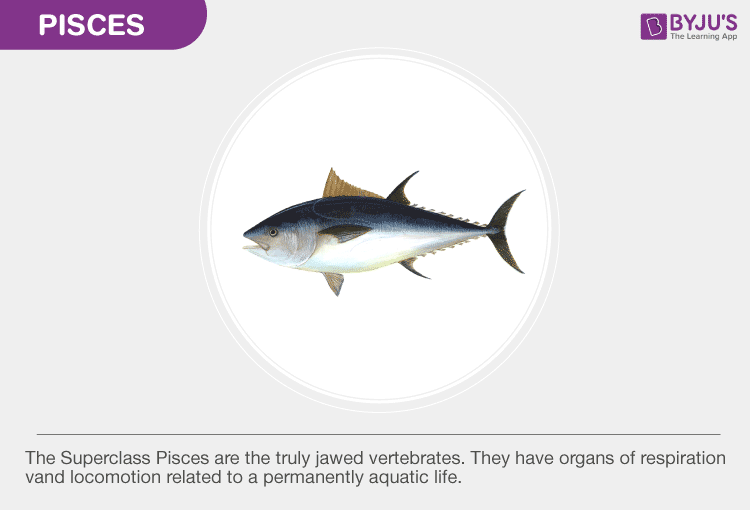These are true, jawed vertebrates with specific organs for respiration, excretion and blood circulation. The organisms belonging to this class are poikilotherms, meaning that they cannot regulate their own body temperature. Essentially, all the fish come in this category.
Kingdom: Animalia
Phylum: Chordata
Class: Pisces

Characteristics of Pisces
- They are found in fresh, marine, and brackish water.
- The body is usually streamlined. Some have a spindle-shaped or elongated body as well.
- Their body is distributed into a head, trunk and tail.
- They swim with the help of their tail.
- Paired and unpaired fins represent the appendages. These help the fish to balance while swimming.
- The lateral line system functions as a sensory organ to sense the disturbances in the nearby environment.
- The body is covered with thick-seated scales, which helps by providing protection to the internal organelles.
- The gills help in respiration.
- Closed type blood circulation is observed.
- The internal skeleton is bony or cartilaginous.
- These are cold-blooded organisms.
- They may be herbivores or carnivores, oviparous or ovoviviparous.
- The sexes are separate.
- Fertilization may be external or internal.
- They lack extra-embryonic membranes.
- The digestive system is well-developed.
- The nervous system comprises of the brain and ten pairs of the cranial nerves.
Also Read: Chordata
Classification of Pisces
Pisces are classified into three categories:
- Placodermi (Aphstohyoids)
- Chondrichthyes
- Osteichthyes
Placodermi (Aphstohyoids)
- All members of this class are extinct today.
- Their exoskeleton is in the form of shields and the endoskeleton is bony.
- These fish exhibit autodiastylic jaw suspension.
- They survived until the end of the Devonian period.
- The heterocercal caudal fin is present.
- Eg., Climatius, Bothriolepis
Chondrichthyes
- These fish are found only in the marine environment.
- The exoskeleton is like placoid scales.
- The endoskeleton is cartilaginous.
- The jaw suspension is amphistylic.
- Gills are the respiratory organs.
- The caudal fin is heterocercal.
- Claspers are the reproductive organs in males.
- These fish do not have air-bladders.
- These are divided into two sub-classes:
- Selachi
- Bradyodonti
- Eg., Heteroloatas, Scoliodon
Osteichthyes
- These fish are found in marine water, freshwater or brackish water.
- They have a bony endoskeleton.
- Autostylic jaw suspension.
- They have no claspers.
- The gills are covered with an operculum.
- The air bladders are present in most of them.
- They are further divided into two sub-classes:
- Crossopterygii
- Actinopterygii
- Eg., Proptopterus, Lepidosiren
Also Read: Respiration In Fish: How Do Fish Breathe?
To know more about the Class Pisces, or other members of the animal kingdom, please visit Byju’s app.

I love your studies